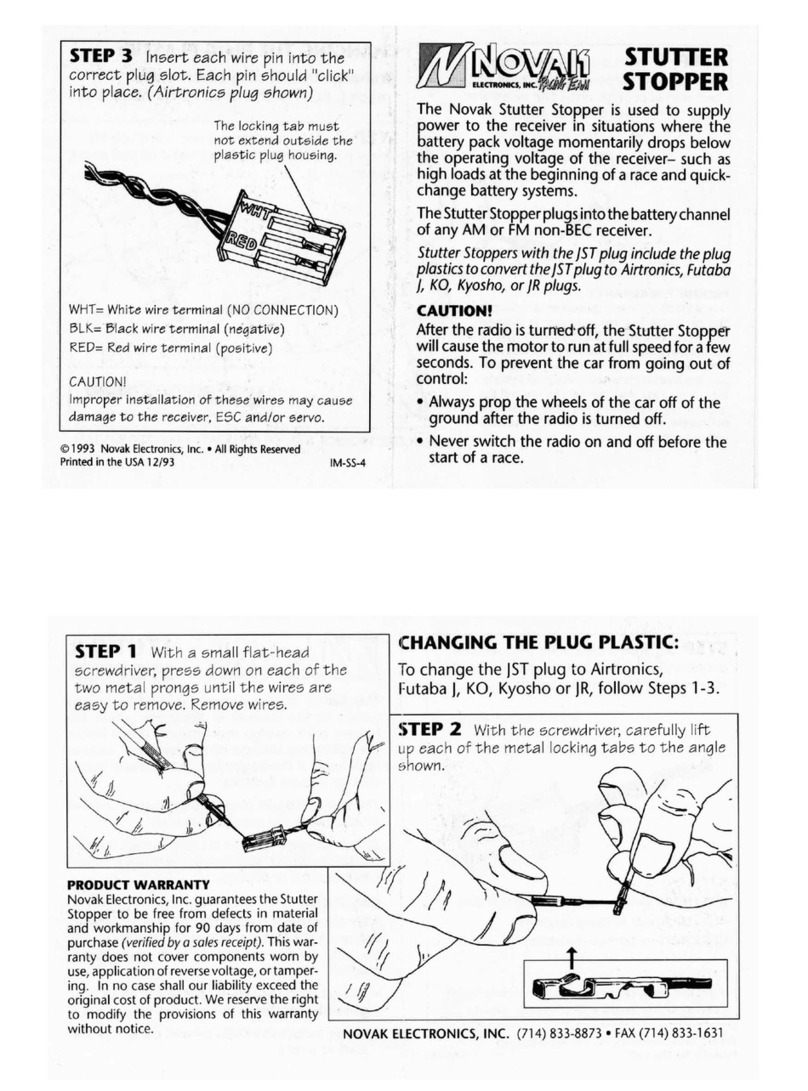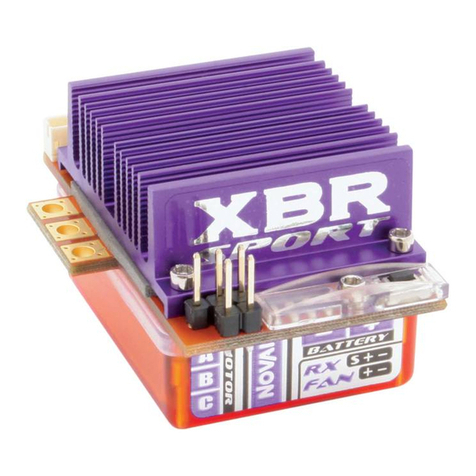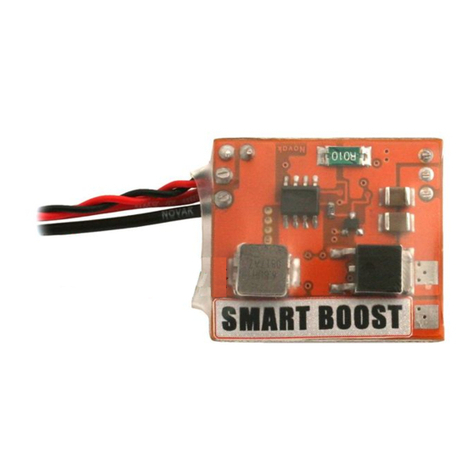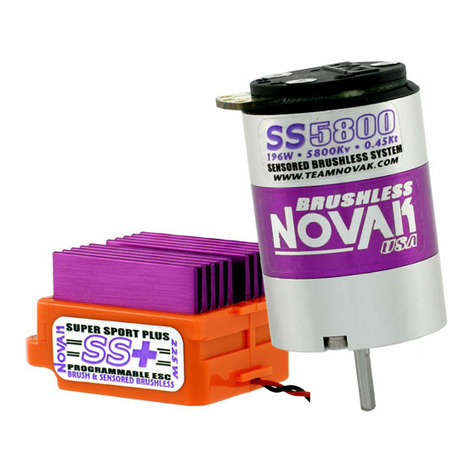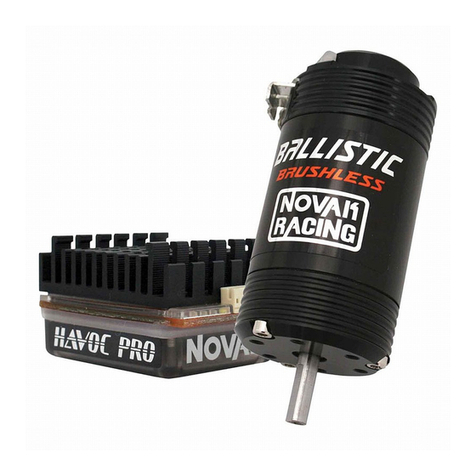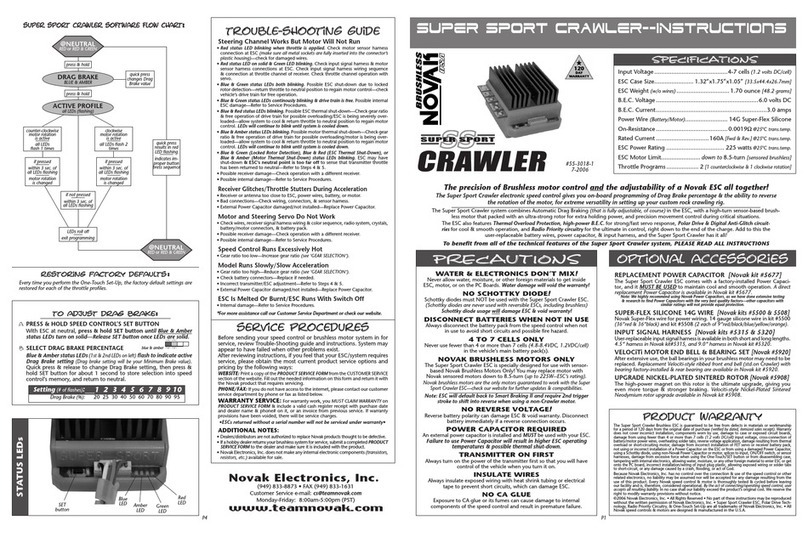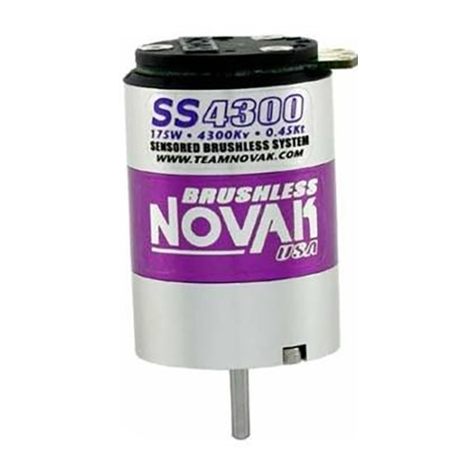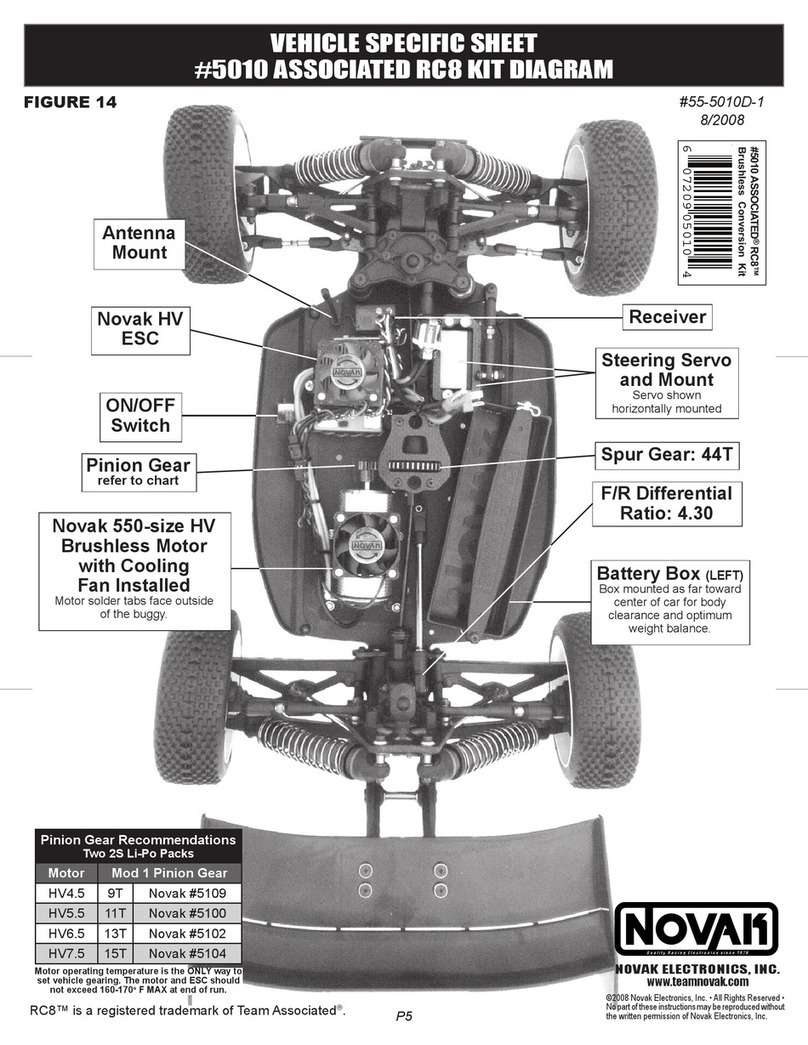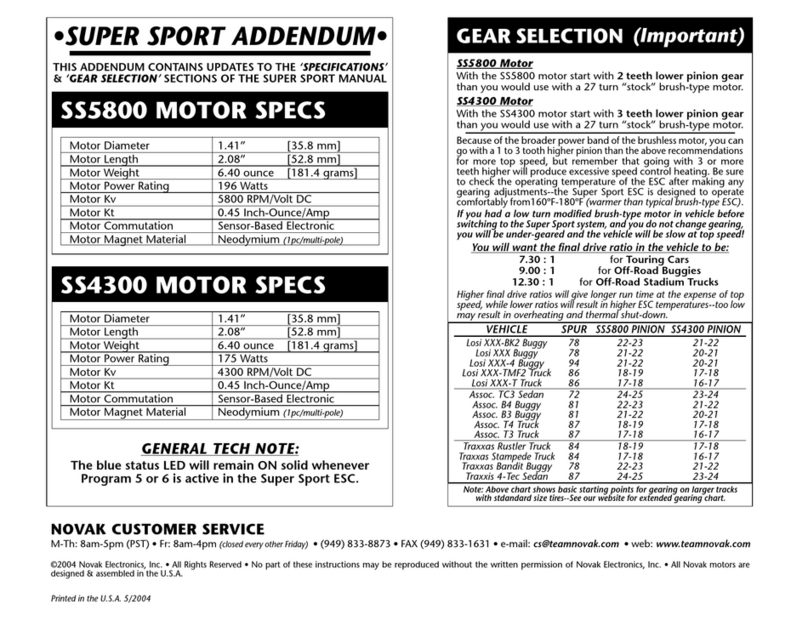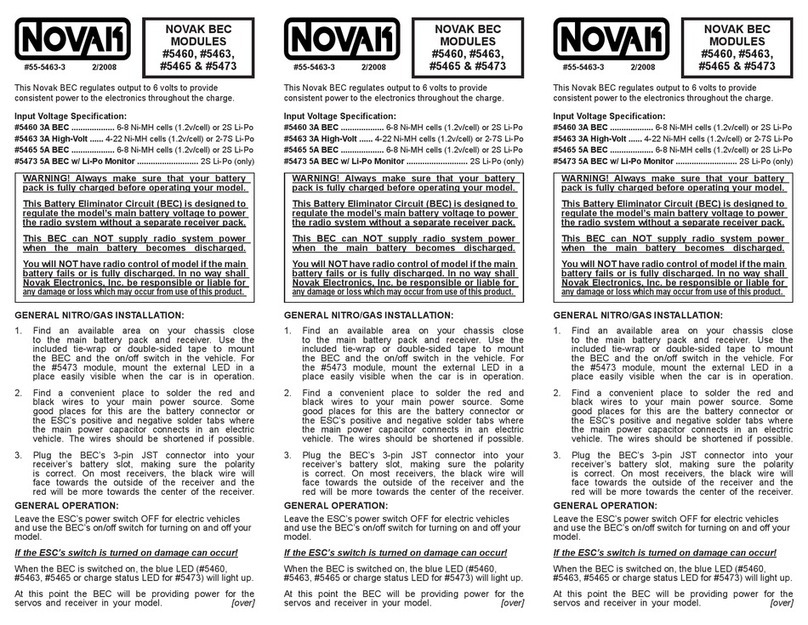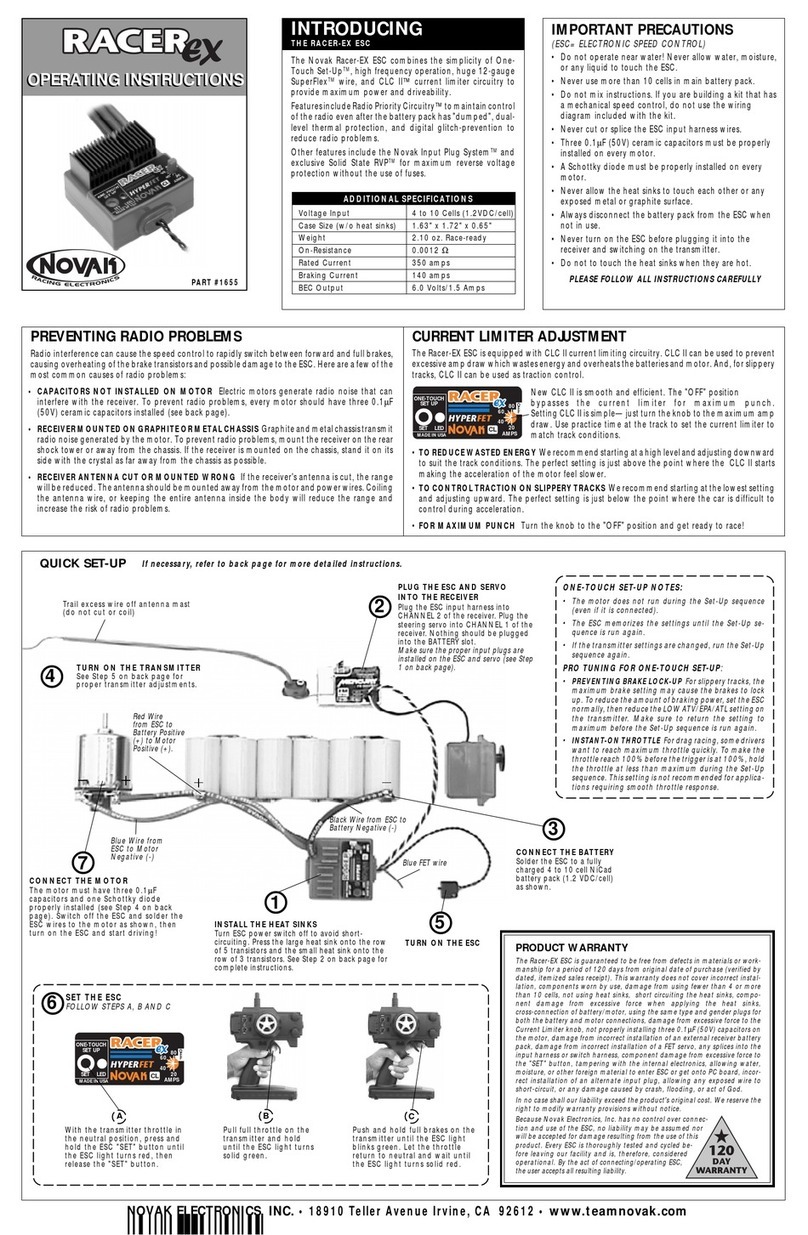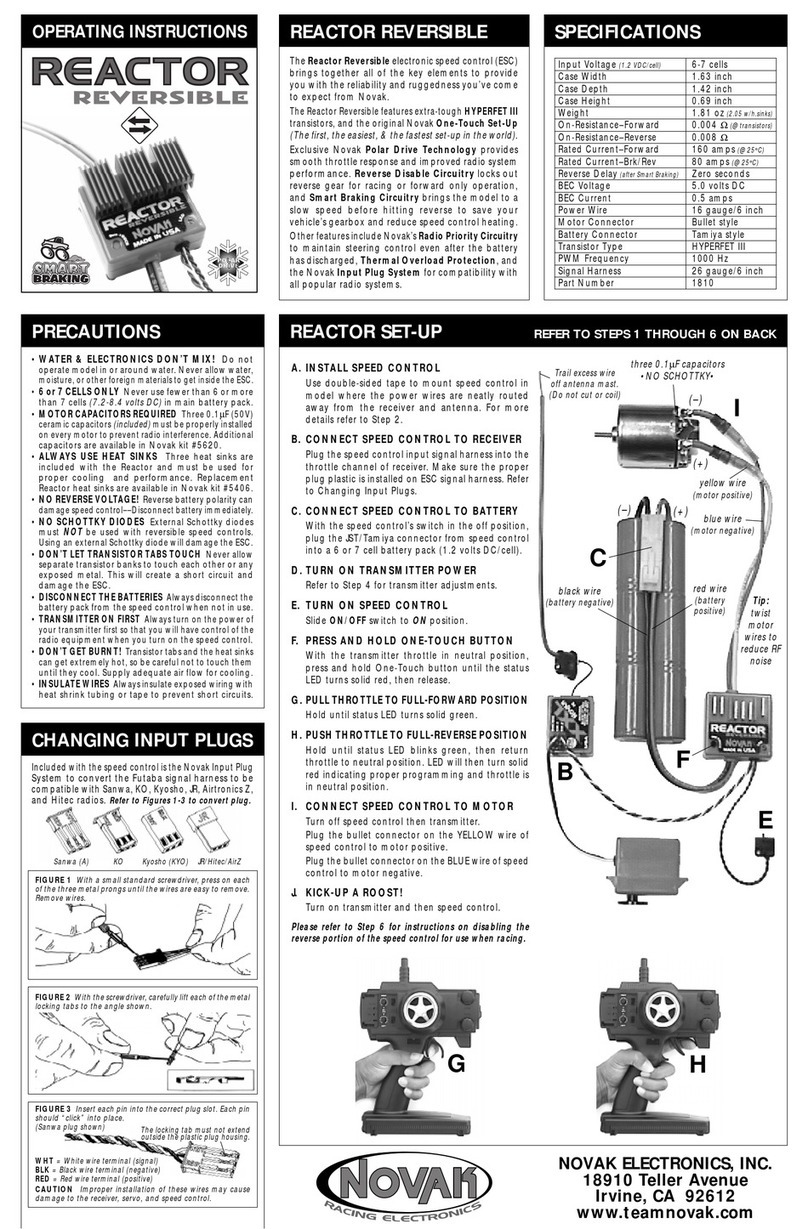NOT ALL TRANSMITTERS HAVE THESE ADJUSTMENTS
havoc pro sc track guide
proper gear selection
2-2011#55-1745P-1 Rev.2
Motor operating temperature is the ONLY
way to properly set vehicle gearing
The Motor and Speed Control should not exceed
160°F MAX at any time during run!
Change the gearing to avoid overheating!
DO NOT FREE-REV MOTOR
!
Free-running your brushless motor in a no-load condition can cause rotor failure
& ESC transistor damage that will not be covered by the product’s warranty.
Because of the potential danger of overheating, ESC/motor damage & failure,
you must start with VERY small pinion sizes and check ESC & motor
temperatures at multiple times throughout the initial runs. This is the only
way to ensure that you are not causing excessive heating.
If ESC & motor temperatures remain low & stable, you can slowly increase
the pinion size while again monitoring the temperatures to determine the
safe gearing for your vehicle, motor, and climate/track conditions. Because
these variables can change or be modified, you MUST continually monitor
ESC & motor temperatures to protect your electronics from damage.
P5
Transmitter adjustments may not be needed to operate the Kinetic ESC.
However, if you have any problems with ONE-TOUCH PROGRAMMING, adjust
the transmitter as follows and repeat the ONE-TOUCH PROGRAMMING step.
THROTTLE CHANNEL ADJUSTMENTS
A.
Set HIGH ATV or EPA to 100% setting. [amount of throw at full throttle]
B.
Set LOW ATV, EPA, or ATL to 100% setting. [amount of throw at full brakes]
C. Set EXPONENTIAL to zero setting. [throttle channel linearity]
D.
Set THROTTLE CHANNEL REV. SWITCH to either position.
E. Set THROTTLE CHANNEL TRIM to middle setting.
[adjusts neutral position/increases or decreases coast brakes]
F.
Set ELECTRONIC TRIGGER THROW ADJUSTMENT to 50%
throttle and
50% brake throw–best for reversible ESCs.
[adjusts trigger throw electronic/digital pistol-grip transmitters]
G.
Set MECHANICAL TRIGGER THROW ADJUSTMENT to position
with 1/2
throttle and 1/2 brake throw.
transmitter adjustments
With the ESC connected to (at least) a charged battery pack, the receiver, and the
brushless motor’s sensor harness:
1. TURN ON THE TRANSMITTER’S POWER
2. PRESS & HOLD ESC’S ONE-TOUCH/SET BUTTON
3. TURN ON THE SPEED CONTROL’S POWER
With transmitter throttle at neutral, and still pressing the
SET button, slide the
ESC’s ON/OFF switch to ON position.
4.
CONTINUE HOLDING SET BUTTON UNTIL RED LED COMES ON
5. RELEASE SET BUTTON AS SOON AS LED TURNS RED
6.
PULL TRANSMITTER THROTTLE TO FULL-ON POSITION
Hold it there until the green status LED turns solid green.
Note: Motor will not run during programming even if connected.
7. PUSH TRANSMITTER THROTTLE TO FULL-BRAKE/REVERSE
Hold it there until the green status LED blinks green.
8. RETURN TRANSMITTER THROTTLE TO NEUTRAL
The red status LED will turn solid red, indicating that speed control is at neutral and
that proper programming has been completed. Blue & yellow LEDs will also be on
indicating Minimum Brake (blue) & Drag Brake (yellow) settings are at levels above 0%.
If transmitter settings are changed, the One-Touch Programming must be repeated.
If you experience any problems, turn off ESC and repeat One-Touch.
NOTE: Whenever the One-Touch Programming is performed, the speed control
will automatically revert back to the factory-default settings.
The
Havoc Pro SC
Racing Brushless ESC
(Novak part number #1745) is factory loaded
with over a dozen programmable features.
While this may seem overwhelming at first
glance, this Havoc Pro SC Track Guide was
designed to keep with you at the track to
use as a quick-reference and help walk you
through the programming of all of the speed
control’s features.
Take the time to thoroughly read through this programming guide before
operation to fully understand the different ESC parameters, and how they can
be used to fine tune your ESC’s feel and performance. Most importantly, enjoy
all of the technical benefits and features the
Havoc Pro SC
ESC has to offer.
Visit our web site for the most up to date information and to learn more
about other Novak products and services.
trouble-shooting guide
Steering Channel Works But Motor Will Not Run
• Possible receiver damage––Check operation with a different receiver.
• Possible internal damage––Refer to ‘SERVICE PROCEDURES’ section.
• Check motor or motor connections.
• Make sure ESC is plugged into the throttle channel of receiver. Check wiring color
sequence of receiver signal harness (Refer to STEP 1).
Receiver Glitches/Throttle Stutters During Acceleration
• Receiver or antenna too close to ESC, power wires, battery, or motor.
• Bad motor sensors, sensor harness, or connections––Check wiring, sensor harness, &
connections, perform hall sensor test (Refer to ‘MOTOR HALL SENSOR TEST’ section).
• Low voltage to receiver––Try Novak Glitch Buster capacitor on receiver to help retain
power during high current draw situations (Novak accessory #5626).
• Power Trans-Cap Module damaged/missing––Replace Power Trans-Cap Module.
• Battery pack damaged or weak––Try a different battery pack.
• Motor magnet weak or overheated––Replace rotor
(Refer to motor manufacturer’s website
).
• Excessive current to motor—Use a milder motor or a smaller pinion gear.
• Untidy wires or signal and power wired bundled together. Input harness and servo
wires should be bundled separately. Power wires should be as short as possible.
Motor and Steering Servo Do Not Work
• Check wires, receiver signal harness wiring & color sequence, radio system, crystals,
battery/motor connectors, & battery pack.
• Possible receiver damage––Check operation with a different receiver.
• Possible internal damage––Refer to Service Procedures.
Motor Runs Backward
• Reverse motor rotation direction––Refer to
‘CUSTOM PROGRAMMING OPTIONS’
section.
• Improper One-Touch set up––Refer to ‘ONE-TOUCH PROGRAMMING’ section.
Timing Does Not Operate Properly
• Improper gearing––Refer to ‘PROPER GEAR SELECTION’ section.
• Motor rotation is set to clockwise––Electronic motor timing advancement only
functions in the counter-clockwise motor rotation direction (refer to ‘CUSTOM
PROGRAMMING OPTIONS’ section).
• Timing Set Point set incorrectly––Refer to ‘CUSTOM PROGRAMMING OPTIONS’ section.
Speed Control Runs Excessively Hot
• Electronic motor timing set too high––reduce timing level setting in ESC.
•
Gear ratio too low––Increase gear ratio/Reduce pinion
(refer to ‘PROPER GEAR SELECTION’).
• Motor is damaged––Try a different motor.
Model Runs Slowly/Slow Acceleration
•
Gear ratio too high––Reduce gear ratio/Increase pinion
(refer to ‘PROPER GEAR SELECTION’).
• Check battery & connectors––Check battery pack & connectors. Replace if needed.
• Incorrect transmitter/ESC adjustment––Refer to ‘TRANSMITTER ADJUSTMENTS’.
• Power Trans-Cap Module damaged/missing––Replace Power Trans-Cap Module.
ESC Is Melted Or Burnt/ESC Runs With Switch Off
• Internal damage––Refer to Service Procedures.
No Power to the BEC
• Check power wire connections to your battery, ESC and BEC unit.
• Check that the input harness from the BEC is plugged into the receiver correctly
and the red wire from the ESC’s input harness is removed.
• Be sure that the BEC unit switch is turned ON.
error codes
• Blue status LED on solid at neutral––Minimum Brake is set to value greater than 0%.
• Yellow status LED on solid at neutral––Drag Brake is set to value greater than 0%.
• Red & Green status LEDs on solid––Check input signal harness connections at ESC
and receiver. Check input signal harness wiring sequence––Refer to STEP 1.
• Red status LED on solid & Green LED blinking––Check motor sensor harness
connection. Possible internal motor damage.
• Blue & Green status LEDs both blinking. Possible ESC shut-down due to locked
rotor detection––return throttle to neutral position to regain motor control––check
vehicle’s drive train for free operation.
• Blue & Red status LEDs blinking. Possible ESC thermal shut-down––Check gear ratio
& free operation of drive train for possible overloading/ESC is being severely over-
loaded––allow system to cool & return throttle to neutral position to regain motor
control. LEDs will continue to blink until system is cooled down.
• Blue & Yellow status LEDs blinking. Possible Motor thermal shut-down––Check gear
ratio & free operation of drive train for possible overloading/Motor is being severely
over-loaded––allow system to cool & return throttle to neutral position to regain
motor control. LEDs will continue to blink until system is cooled down.
• Blue & Green (Locked Rotor Detection), Blue & Red (ESC Thermal Shut-Down), or
Blue & Yellow (Motor Thermal Shut-Down) status LEDs blinking. ESC may have shut-
down & ESC’s neutral point is too far off to sense that transmitter throttle has
been returned to neutral (Refer to ‘ONE-TOUCH’ & ‘TRANSMITTER ADJUSTMENTS’).
• Green & White status LEDs blinking.
RPM safety limit reached & physical limit of motor
bearings being reached/Possible over-rev condition. Increase gear ratio or reduce pinion.
• White status LED blinking. ESC timing is turned ON. ESC is operating normal.
• Red & Green status LEDs toggling. LiPo/LiFe Safety Cut-Off voltage reached. Remove
and charge/replace battery pack.
Check Novak’s web site for additional information.
temperature OVERLOAD
P8
To conform to ROAR’s Sportsman Class racing rules and help race organizers
monitor driver compliance in non-timing race classes, we have included a
feature in this speed control that indicates when the ESC has its electronic
motor timing advancement feature activated.
At all times when the speed control is powered ON and the Dynamic Motor
Timing is turned ON and set to a level greater than zero timing advance,
the ESC’s white status LED will be illuminated during normal operation.
Due to the nature of timing advance speed controls, motor tolerances &
settings, vehicle performance, and track conditions, it has become virtually
impossible to provide installation and operation recommendations that
will allow you to use these speed controls and motors at their highest
performance levels without the potential for unwanted damage.
You must, use extreme caution when setting up these electronics and
carefully test your application to avoid overloading and overheating
either the speed control or the motor.
These are racing electronics used
in racing conditions, and therefore damage as the result of excessive
overheating will not be covered under the product’s factory warranty.
Electronic motor timing advancement can generate extrememly high speeds and
result in an uncontrollable vehicle. Use caution when operating vehicle and do not
operate around other people or in an unsafe manner to avoid injuries or damage.
one-touch programming
timing esc warning
esc parameters
motor hall sensor test
timing indicator led
1. Minimum Brake (1 of 10) .......................................................... 0-30%
2. Drag Brake (1 of 10) .................................................................. 0-30%
3. Minimum Drive (1 or 10) ...........................................................0-15%
4. Timing Level
(1 of 8)
.....................................................................0-42°
5. Timing Set Point
(1 of 8)
............................................ 4000-19500 RPM
6. Dead Band (1 of 5) ...................................................................... 2-8%
7. Throttle Curve (1 of 2) ............................................ Linear/Exponential
8. Brake Curve (1 of 2) ................................................ Linear/Exponential
9. Brake Frequency (1 of 10) ...............................................1.67-13.7KHz
10.
Brake End Point (1 of 10)....................................................... 10-100%
11.
Drive Frequency (1 of 10) ........................................................7-16 KHz
12.
Reverse ................................................................................... OFF/ON
13.
Motor Rotation ..................................................................... CCW/CW
14.
Voltage Cut-Off ..............................................................OFF -LiPo-LiFe
The Hall Sensor Test diagnostic feature in Havoc Pro SC allows you to easily
check the sensors in the brushless motor connected to the ESC to determine if
they are operating normally. This will help you pinpoint the cause of problems
in your system, and hopefully reduce the down time and expenses associated
with sending your product in for service when you can resolve the issue yourself.
To access this feature, simply follow these steps:
1. Follow the steps in the ‘CUSTOM PROGRAMMING OPTIONS’ section
to access the Hall Sensor Test option via the ESC’s SET button.
2. Slowly rotate the motor’s output/pinion shaft. If motor is installed in
a vehicle, slowly rotate the drive train so that the motor also rotates.
3. The status LEDs on the speed control should cycle through illuminating
the BLUE, YELLOW, and RED status LEDs.
If the BLUE, YELLOW, and RED LEDs light up one after another as the motor’s
shaft is rotated, the Hall Sensors in the motor are operating normally.
If any one of the BLUE, YELLOW, or RED status LEDs do not light while rotating
the motor’s shaft, there is a either a problem with the Sensor Harness Cable
(or its connections either at the motor end or the ESC end) or with the actual
Hall Effect Sensors in the motor’s timing section.
If your motor has a user-replaceable double-ended sensor harness, replace
it with another one to determine if this is this source of the problem. If, after
replacing the harness, all three of the LEDs still do not light up, it would
appear that one of the sensors inside the motor has been damaged--replace
the timing section of your motor, or if your motor is not user-rebuildable,
send it in the manufacturer for the appropriate service.
The Havoc Pro SC ESC features Novak’s Smart-Stop Voltage Cut-Off Circuitry
built-in, and when used properly will allow you to safely use LiPo and LiFe
batteries, without letting the cells drop below their critical safety voltage.
The default in the ESC is LiPo voltage cut-off. If using NiMH or NiCd cells,
you will need to switch this feature off. If using LiFe cells, you will need to
switch to the LiFe battery setting.
Note: Whenever the speed control’s One-Touch Programming is
performed, this setting will revert to the LiPo default setting.
DO NOT USE LiPo/LiFe BATTERIES WITH VOLTAGE CUT-OFF TURNED OFF
voltage cut-off circuitry
www.teamnovak.com
temperature monitoring
With the higher performance of brushless systems, undesirable radio system
noise may occur when used with lower quality radio systems. 2.4GHz radio
systems are the best to use. FM radio systems are acceptable, as long as
the system is high quality. AM radio systems are NOT recommended.
Best to use
2.4 GHz
OK to use
FM
Do not use
AM
GOOD QUALITY RADIO SYSTEM SUGGESTED
The Havoc Pro SC has a built-in diagnostic temperature monitoring feature
that lets you quickly check the ESC’s operating temperature at any time.
While connected to a battery and powered ON, simply tap the ESC’s SET
button and one of the on-board LED lights will flash 4 times to indicate the
operating temperature of the speed control.
WHITE flashing LED = normal operating temp--under 135°F (57°C).
BLUE flashing LED = medium operating temp--136-147°F (58-64°C).
YELLOW flashing LED = hot operating temp--148-167°F (65-75°C).
GREEN flashing LED = hotter operating temp--168-194°F (76-90°C).
RED flashing LED = hottest operating temp--195-215°F (91-102°C).
You are now pushing the ESC extremely hard and should be very
careful to avoid overheating and possible thermal shut-down.
All LEDs flashing = DANGEROUS operating temp--216-239°F (103-115°C).
Your ESC is now about to thermally shut-down.
---Reduce the pinion size to avoid overheating and potential ESC damage---
The Havoc Pro SC ESC has built-in ESC temperature overload protection
that will turn off the Dynamic Timing Advance feature and will also limit
the power to the motor in an attempt to prevent thermal overloading of
the speed control. While this feature can not guarantee the survival of
the speed control when subjected to conditions that produce excessive
heating of the electronics, it does provide another tool that you can use
to avoid extensive damage.
If you notice a significant decrease in performance of your brushless
system during a run, immediately check the operating temperatures
of the speed control and the motor. Reduce gearing or ESC timing
settings to lower operating temperatures!


